冬の魚沼、一日散歩/Taking a walk in Uonuma area in a winter day
毎年冬になると、越後湯沢のマンションに一人で籠るのが習慣になっています。今年はサラリーマン時代の戦友が日帰りで訪ねてきてくれたので、一日かけて魚沼周辺の観光地を車で巡ることにしました。
Every winter, it has become a habit for me to stay alone in a condominium in Echigo Yuzawa. This year, a former colleague from my officeworking days visited me for the day, so we decided to spend the day touring the sightseeing spots around Uonuma area by car.
(English text continues to the latter half of the page)
アートの力で一躍有名観光地に躍り出た「清津峡」
早朝に東京から越後湯沢駅に新幹線で到着した彼をまず連れて行ったのは湯沢から車で30分ほどの「清津峡」。紅葉の季節には絶景が広がるダイナミックな柱状節理が立ち並ぶ清津渓谷。この渓谷の奥深くまで安全に観光できるように1996年に観光トンネルを掘り、3か所の見晴らし台を設けた観光の名所。ところがここが新潟県人のアピール力不足と言うか、ここまで投資をした観光拠点だと言うのに、ほとんど観光客に見つけられることなく閑古鳥が鳴くような有り様。我が家が初めてここを訪れたのは90年代後半でしたが、実に“孤独を楽しむのに最高”なトンネルとなっていました。当時の入場料は300円くらいだったかな。
ところが越後妻有(えちごつまり)地域を舞台に3年に一度行われる「大地の芸術祭」が2018年にこの清津峡トンネルで現代アートのインスタレーションを行ったことで、この僻地の観光施設の運命が大きく変わります。トンネルの各所に仕掛けられた現代アートの仕掛け、特にトンネル最深部の見晴らし台に建設された水盤と反射材を用いたドーム構造は外の渓谷美をこれまで誰も見たことのない形でトンネル内に映し出しました。その光景は国内のメディアのほか、多くの海外インフルエンサーによって拡散、共有されてあっという間にハイシーズンには朝早くに入場が打ち切られるほどの一大観光拠点になりました。ほんのちょっとした工夫と情報拡散で観光地は生き返ることができるという好例となったわけです。

これがトンネル最深部の光景。現在は雪化粧の渓谷美が映し出されているけど、四季の風景に応じた様々な光景がこの水盤とドーム状の天井に映し出されます。この水盤は周囲が浅く、靴のまま渡っていくことができるため、多くの観光客が端まで歩いていって様々なポーズを決めています。
トンネルには朝9:00の開場と同時に入洞、現在の入場料は1,000円。我々が一番乗りだったけど、すぐ後ろにインド人とフィリピン人のコンビが続き、途中から彼らと一緒に歩くことに。
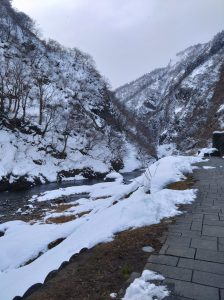
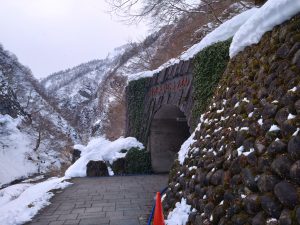
雪に包まれたトンネル前の渓谷と、トンネル入り口。




トンネルの途中に穿たれた見晴台からの光景。トンネルができる前はこうした光景を見るために、崖の上部に作られた危険な遊歩道(現在は通行禁止)をトレッキングして多くの事故があったらしい。

見晴台の一つに作られたアート作品の一つ。実はこれ、公衆トイレ(水洗)なんです。
ここからトンネルの最終地点へ。薄暗いトンネルをU字型に曲がり、水盤の前に出ると息をのむ光景が待っているという演出。アートの力を感じます。
水盤の周囲を4人で歩き回っていると、いきなりインド人が靴と靴下を脱いでジャブジャブと水盤の中央付近を歩き出した!まあ想い出のワンシーンだと思うけど外は氷点下、冷たい思い以上の善き想い出になったことを願います。


“日本のミケランジェロ”石川運蝶の集大成、西福寺開山堂
次に向かったのは、六日町と小出の間の山麓に位置する西福寺。全国的にはまだあまり知名度の高くないこの寺には、ちょっと驚くような資源が眠っています。それは石川運蝶(1814‐1883)という幕末に透し彫りの技法を得意とした彫工職人の一連の作品です。以前にも訪れたことがありますが、堂内は撮影厳禁。ところが今回はどういった理由なのかはともかく、自由に撮影して構わないと言ってもらえるという特典がつきました!あらかじめ電話とメールで訪問を予約していて二人だけの拝観だったためかどうかはわかりませんが、千載一遇のチャンスと、(もちろんフラッシュはオフにしましたが)多くの写真を撮ることができました。
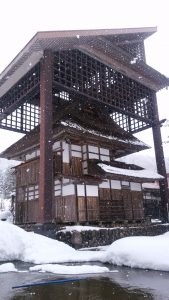

これが多くの作品を納めた開山堂。そして下の動画を見て、ここに入っていった瞬間の驚きを少しでも感じてもらいたいと考えています。
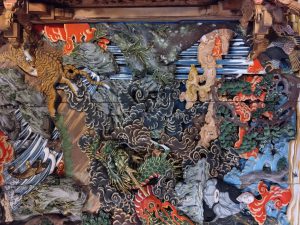


天井を埋め尽くす透し彫り、曹洞宗の道元禅師の逸話(猛虎調伏)を描いたスペクタクルな場面ですが、岩絵具によって着色された160年以上前の色彩が以降一度も塗り直されないまま現代までその輝きを保ち続けています。
何よりもこの透し彫りのダイナミックな技巧、近くで見ると20㎝ほどの厚さの板になん重にも重なった造形が施されている「透し彫り」という技法ですが、奥の深いところなんかはどうやってノミを入れて彫ったのか想像がつきません。「透し彫り」というよりも「彫刻」そのもの。一枚の平板な板の中にここまで立体的な世界を表現した作品はほかに見たことがない。

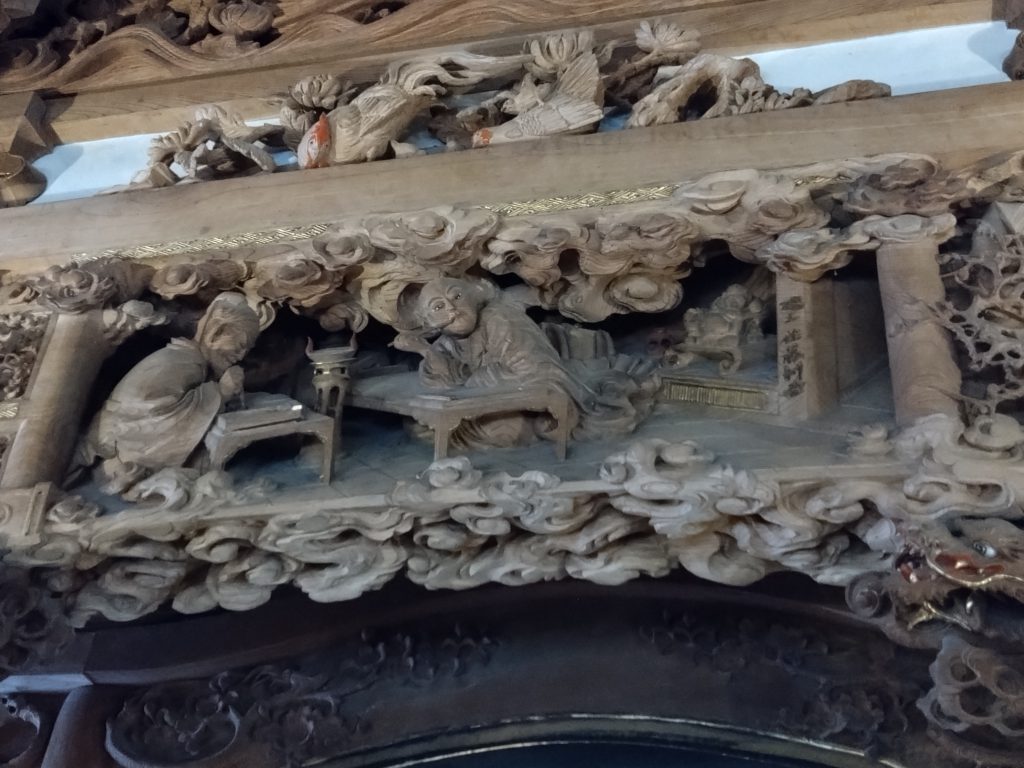
個人的に一番驚いたのはこの作品。これも道元禅師のエピソードにまつわる作品ですが、何が凄いかわかるでしょうか。これは『3次元の遠近法』なんです。もともと3次元の世界の距離感を2次元の絵画の中で表現するためにルネッサンス期に一般に広がる遠近法ですが、この作品では、ほんの20㎝くらいの厚さの板の中で1mくらいの文机の奥行きを表現するためにパーツごとに微妙なデフォルメを施しています。いったいこんな技法の教科書がどこかにあるのか?自分の知見が不足しているのもあるけど、こんなものは見たことがない!おそらくは石川運蝶自身が考案して、彼がただ一人辿り着いた境地だったのではないか。そして恐らくこのことが、石川運蝶が最近まで忘れられていた本質的な要因だったのではないかとも感じます。
石川運蝶についてはあまり詳細な記録がのこっていないのですが、1814年に江戸は雑司ヶ谷に生まれ、20代の頃には幕府御用達を努めるほどに職人としての地位を確立したらしい。ところがその後、越後三条の商人がパトロンとなり現在の新潟県に移り住み、新潟の寺社仏閣を中心に精力的に作品を残していきます。その分野は透し彫りに留まらず、彫刻、絵画、鏝絵(こてえ)にまで至り、いずれも伝統技法を超越した独自の境地を見せます。彼が新潟に移り住んだ詳しい経緯は分かっていないものの、一説ではパトロンから「ノミと酒には一生事欠かないようにする」との一筆で移り住んだとも言われ、酒に関する逸話も各地に数多く残っているようです。彼には子供も弟子もいたようですが、石川運蝶独自の技法と境地は彼自身しか体現することができず、彼がたった一人で辿り着いた境地と作品群は、中央(江戸)から遠く離れた越後の地で忘れ去られていったようです。
世間から半ば忘れられた石川運蝶に再び光を当てたのは、新潟県在住の木原尚氏で1991年から地方紙の新潟日報に記事を連載し、それ以降TVでもたびたび取り上げられるようになると、新潟各地から「そう言えばうちの寺にもこんな作品がある」という声が続々と寄せられ、150年ぶりの石川運蝶ブームが訪れました。
それにしてもここまでダイレクトに人の眼を奪う鮮烈な作品が、世間に知られることなく眠っていたところに、いかにも新潟県人の奥ゆかしさと言うかPR下手を感じてしまいます。


石川運蝶の洒落っ気を表す造形。廊下の床板の節目を修復したところを、花瓶にさした菖蒲や小槌のように見せています。







塩沢町(現南魚沼市)の銘酒「鶴齢」のこの看板も石川運蝶の手によるものだそう。
ランチは駅前食堂、なのにこの特別感は?
石川運蝶の世界にたっぷりと浸った後は、車で10分ほどの小出駅(JR東日本上越線及び只見線)へ。駅前食堂の「富貴亭」は特に何のオーラもない外見ですが、新潟の凄いところはこうした何の変哲もない街の食堂が実は他では見られないようなメニューを出すところです。やたらにお話し好きなおばちゃんがやっているこの食堂で「イワナ定食」を頼むと、水槽から丸々と太った岩魚をすくって焼いてくれるんです。遠火で焼く伝統的な焼き方なので、けっこう時間はかかりますが、その味は絶品!ちなみに味噌カツどんも名物です。


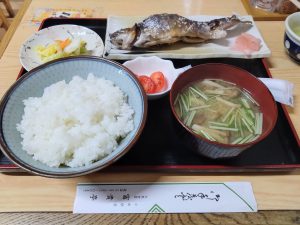

“Kiyotsukyo Gorge,” which suddenly became a famous tourist spot with the power of art
The first place I took him after arriving at Echigo-Yuzawa Station from Tokyo early in the morning was “Kiyotsukyo Gorge,” about a 30-minute drive from Yuzawa station. Kiyotsu Gorge, where dynamic columnar joints spread out with stunning views during the autumn color season. In order to safely tour deep into the valley, a tourist tunnel was dug in 1996, and three observation decks were set up, making it a famous tourist spot. However, despite being such a heavily invested tourist spot, there were hardly any tourists to be found, and it was almost deserted. The first time our family visited here was in the late 1990s, and it was truly a “perfect place to enjoy solitude.” The entrance fee at that time was around 300 yen.
However, the fate of this remote tourist facility changed dramatically in 2018 when the “Echigo-Tsumari Art Triennale,” held once every three years in the Echigo-Tsumari region, conducted a contemporary art installation in the Kiyotsukyo Gorge tunnel. The contemporary art installations set up throughout the tunnel, especially the dome structure with a water basin and reflective material built at the deepest part of the tunnel, projected the beauty of the outside valley in a way that no one had ever seen before inside the tunnel. This spectacle was quickly shared and spread by domestic media as well as many overseas influencers, turning it into a major tourist attraction where admission was sold out early in the morning during the peak season. It became a great example that with just a little ingenuity and information dissemination, a tourist destination can be revived.

This is the view at the deepest part of the tunnel. Currently, the snow-covered beauty of the valley is being reflected, but various scenes according to the seasons’ landscapes are projected onto this water basin and dome-shaped ceiling. Since the water basin is shallow around it, visitors can walk to the edge in their shoes and strike various poses.
The tunnel opens at 9:00 in the morning, and the current admission fee is 1,000 yen. Although we were the first ones to enter, we were soon joined by a duo of an Indian and a Filipino walking behind us, and we ended up walking with them from halfway through.


The valley in front of the tunnel covered in snow, and the entrance to the tunnel.


The view from the observation deck halfway through the tunnel. Before the tunnel was built, people used to trek along dangerous pathways built on the cliffs (now prohibited) to see such views, which led to many accidents.

One of the art installations created on the observation deck. Interestingly, this is actually a public restroom (flush toilet).
Moving on to the final destination of the tunnel from here. As you curve around the dim tunnel in a U-shape and emerge in front of the water basin, you are greeted by a breathtaking scene, an artistic setup that truly makes you feel the power of art.
As we were walking around the perimeter of the water basin with four people, suddenly an Indian guy took off their shoes and socks and started walking around in the middle of the water basin! Well, I suppose it’s a memorable scene, but considering it was below freezing outside, I hope it became a better memory than a cold one.


The Magnum Opus of Japan’s Michelangelo”: Saifukuji Temple’s Kaizando Hall by Ishikawa Uncho
Next, we headed to Saifukuji Temple, located in the foothills between Muikamachi and Koide. This temple, not yet widely known nationwide, holds a somewhat surprising treasure. That is a series of works by Ishikawa Uncho (1814-1883), a craftsman specializing in the technique of relief carving during the late Edo period. I had visited before, but photography inside the hall was strictly prohibited. However, for some reason this time, perhaps due to a prior reservation made by phone and email, we were granted the privilege to freely take photographs! Whether it was because it was just the two of us for the visit or for some other reason, I’m not sure, but it was an exceptional opportunity, and (of course, with the flash turned off) we were able to capture many photos.


Here is the Kaizando Hall housing many works. And I hope you can feel even a little bit of the surprise of entering here by watching the video below.



It’s a spectacular scene depicting the anecdote of Dogen Zenji, the founder of the Soto school of Zen Buddhism, called “Subduing the Fierce Tiger,” carved in exquisite transom carvings that fill the ceiling. The vibrant colors, painted with mineral pigments over 160 years ago, have remained unchanged since then, preserving their brilliance to the present day without ever being repainted.
Above all, the dynamic craftsmanship of this transom carving is remarkable. When viewed up close, it’s astounding to see the layers upon layers of relief carvings on boards about 20 cm thick. It’s hard to imagine how they carved the intricate details deep into the wood. Rather than merely “transom carving,” it feels more like pure sculpture. I’ve never seen another work that expresses such a three-dimensional world within a single flat board.


What amazed me the most is this particular piece of artwork. It’s also related to an episode of Dogen Zenji, but do you know what’s incredible about it? It’s the “3D perspective” incorporated into the carving. Originally developed during the Renaissance period to depict the sense of distance in a three-dimensional world within a two-dimensional painting, this artwork employs “perspective” to convey depth within a mere 20 cm thick board, creating an illusion of depth similar to three-dimensional space. How on earth did they achieve this technique? It’s beyond my imagination. Rather than just “transom carving,” it feels like pure “sculpture.” I’ve never seen another piece that expresses such a vivid three-dimensional world within a single flat board.
There aren’t many detailed records remaining about Ishikawa Unto, but he was born in 1814 in Zoshigaya, Edo (modern-day Tokyo). By his twenties, he had established himself as a skilled artisan to the extent of being employed by the Shogunate. However, later on, he moved to Niigata Prefecture, where a merchant from Sanjo, Echigo Province, became his patron. There, he energetically produced works primarily for temples and shrines in the Niigata area. His talents extended beyond transom carving to include sculpture, painting, and Kote-e (trowel painting), demonstrating a unique artistic mastery that surpassed traditional techniques. While the exact circumstances of his relocation to Niigata remain unclear, it’s said that his patron’s word, promising him “a lifetime supply of chisels and sake,” persuaded him to move. Anecdotes about his fondness for sake are still prevalent in various regions. Although he had children and disciples, Ishikawa Uncho’s unique techniques and artistic mastery were embodied only by himself. His achievements were seemingly forgotten in the distant Echigo region, far from the central hub of Edo.
The rediscovery of Ishikawa Uncho was spurred by Hisashi Kihara, a resident of Niigata Prefecture. Starting in 1991, Kihara serialized articles in the local newspaper Niigata Nippo, and subsequently, his works were frequently featured on television. As a result, voices from various locations in Niigata began to emerge, saying, “Come to think of it, we have such works in our temple too,” leading to a resurgence of interest in Ishikawa Uncho’s art, marking the end of a 150-year hiatus.
Nevertheless, it’s remarkable how such vivid and captivating works of art remained hidden from the public eye due to the reticence or lack of publicity skills among the people of Niigata.


This is a playful representation showcasing Ishikawa Uncho’s wit. When repairing the joints of the corridor floorboards, they were made to resemble irises or hammers inserted into vases, adding a touch of elegance and whimsy to the otherwise mundane task of repair.







The signboard for “Kakurei,” a famous sake from Shiozawa Town (now part of Minamiuonuma City), is also said to be the work of Ishikawa Uncho.
Lunch at the station-front diner, yet it feels so special?
After immersing ourselves in the world of Ishikawa Uncho, we drove about 10 minutes to Koide Station (on the JR East Joetsu Line and Tadami Line). “Fukitei,” the diner in front of the station, doesn’t particularly stand out from the outside, but what’s amazing about Niigata is that these unassuming local diners often serve menus you won’t find anywhere else. At this diner run by a chatty older lady, I ordered the “Iwana Set Meal,” and she scooped out a plump char directly from the tank and grilled it for me. It takes a while as they grill it slowly over low heat in the traditional way, but the taste is exquisite! By the way, their miso katsu don is also a specialty.




